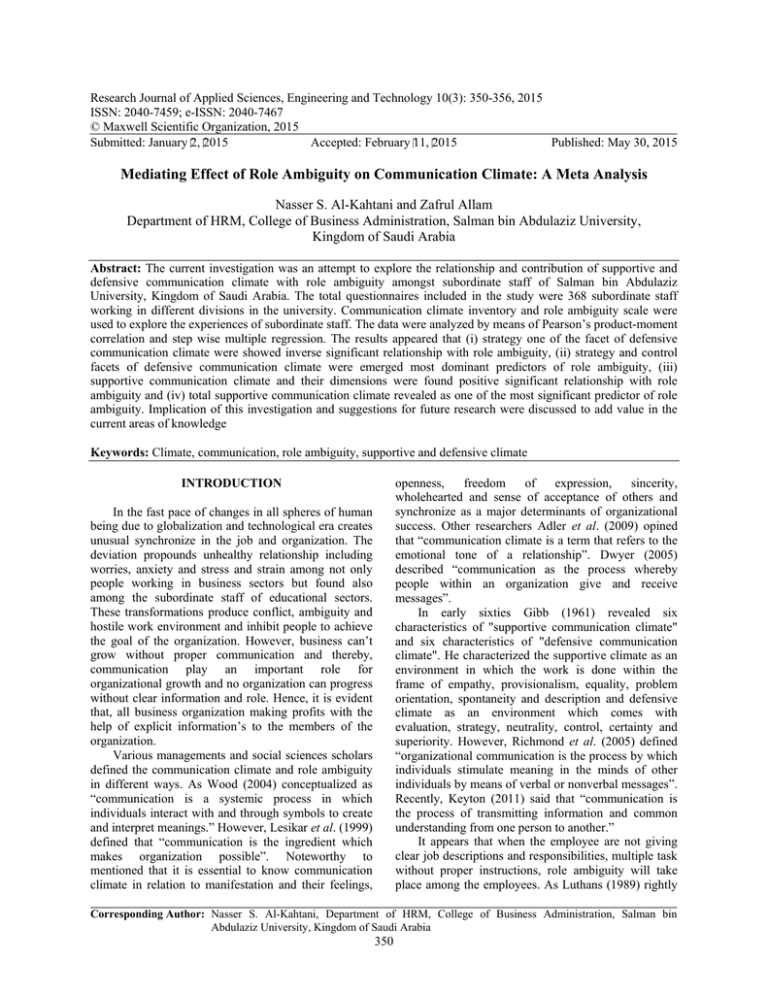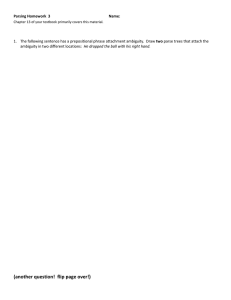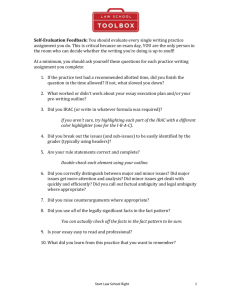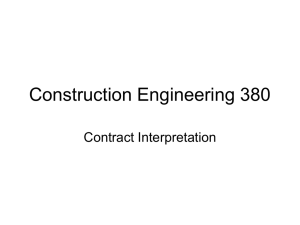Research Journal of Applied Sciences, Engineering and Technology 10(3): 350-356,... ISSN: 2040-7459; e-ISSN: 2040-7467
advertisement

Research Journal of Applied Sciences, Engineering and Technology 10(3): 350-356, 2015 ISSN: 2040-7459; e-ISSN: 2040-7467 © Maxwell Scientific Organization, 2015 Submitted: January 2, 2015 Accepted: February 11, 2015 Published: May 30, 2015 Mediating Effect of Role Ambiguity on Communication Climate: A Meta Analysis Nasser S. Al-Kahtani and Zafrul Allam Department of HRM, College of Business Administration, Salman bin Abdulaziz University, Kingdom of Saudi Arabia Abstract: The current investigation was an attempt to explore the relationship and contribution of supportive and defensive communication climate with role ambiguity amongst subordinate staff of Salman bin Abdulaziz University, Kingdom of Saudi Arabia. The total questionnaires included in the study were 368 subordinate staff working in different divisions in the university. Communication climate inventory and role ambiguity scale were used to explore the experiences of subordinate staff. The data were analyzed by means of Pearson’s product-moment correlation and step wise multiple regression. The results appeared that (i) strategy one of the facet of defensive communication climate were showed inverse significant relationship with role ambiguity, (ii) strategy and control facets of defensive communication climate were emerged most dominant predictors of role ambiguity, (iii) supportive communication climate and their dimensions were found positive significant relationship with role ambiguity and (iv) total supportive communication climate revealed as one of the most significant predictor of role ambiguity. Implication of this investigation and suggestions for future research were discussed to add value in the current areas of knowledge Keywords: Climate, communication, role ambiguity, supportive and defensive climate openness, freedom of expression, sincerity, wholehearted and sense of acceptance of others and synchronize as a major determinants of organizational success. Other researchers Adler et al. (2009) opined that “communication climate is a term that refers to the emotional tone of a relationship”. Dwyer (2005) described “communication as the process whereby people within an organization give and receive messages”. In early sixties Gibb (1961) revealed six characteristics of "supportive communication climate" and six characteristics of "defensive communication climate". He characterized the supportive climate as an environment in which the work is done within the frame of empathy, provisionalism, equality, problem orientation, spontaneity and description and defensive climate as an environment which comes with evaluation, strategy, neutrality, control, certainty and superiority. However, Richmond et al. (2005) defined “organizational communication is the process by which individuals stimulate meaning in the minds of other individuals by means of verbal or nonverbal messages”. Recently, Keyton (2011) said that “communication is the process of transmitting information and common understanding from one person to another.” It appears that when the employee are not giving clear job descriptions and responsibilities, multiple task without proper instructions, role ambiguity will take place among the employees. As Luthans (1989) rightly INTRODUCTION In the fast pace of changes in all spheres of human being due to globalization and technological era creates unusual synchronize in the job and organization. The deviation propounds unhealthy relationship including worries, anxiety and stress and strain among not only people working in business sectors but found also among the subordinate staff of educational sectors. These transformations produce conflict, ambiguity and hostile work environment and inhibit people to achieve the goal of the organization. However, business can’t grow without proper communication and thereby, communication play an important role for organizational growth and no organization can progress without clear information and role. Hence, it is evident that, all business organization making profits with the help of explicit information’s to the members of the organization. Various managements and social sciences scholars defined the communication climate and role ambiguity in different ways. As Wood (2004) conceptualized as “communication is a systemic process in which individuals interact with and through symbols to create and interpret meanings.” However, Lesikar et al. (1999) defined that “communication is the ingredient which makes organization possible”. Noteworthy to mentioned that it is essential to know communication climate in relation to manifestation and their feelings, Corresponding Author: Nasser S. Al-Kahtani, Department of HRM, College of Business Administration, Salman bin Abdulaziz University, Kingdom of Saudi Arabia 350 Res. J. App. Sci. Eng. Technol., 10(3): 350-356, 2015 pointed that role ambiguity has been found due to inadequate knowledge or information to carry out the task. The reasons for such ambiguity may consists of inadequate information or knowledge to do a job. This ambiguity may be due to poor communication, inadequate training, distortion of information or the deliberate withholding by a colleague or peers coworker or administrator. Moreover, Rizzo et al. (1970) defined role ambiguity as “reflect certainty about duties, authority, allocation of time and relationships with others; the clarity or existence of guides, directives, policies; and the ability to predict sanctions as outcomes of behavior”. Kahn et al. (1964) conceptualized “role ambiguity as the situation that the individual does not know his job description and what is expected from him/her clearly”. In addition, the roles and responsibilities pertaining to job in a situation of role ambiguity, the duties and achievements related to job obligation are not completely understand and the significances of role actions cannot be assumed (Sinha and Subramanian, 2012). Jones (2007) opined that “role ambiguity occurs when a person's tasks or authority are not clearly defined and the person becomes afraid to act on or take responsibility for anything”. It is more worthy to highlights that lack of proper communication and unclear job descriptions might led to hidden the performance of the organization. Zhao and Rashid (2010) described “role Ambiguity as the absence of satisfactory information which is required in order for persons to accomplish their role in a satisfactory manner”. defensive action emphasized on interpersonal relationships. Hajdasz (2012) carry forward the Gibb’s model of supportive and defensive communication climate and results focused on factors that affect the feelings of communication climate. Further researcher focused that supportive and defensive communication leads to positive and negative communication but negative influence of defensive communication overrides the positive impact of supportive communication on the on the rise communication climate. Kahtani and Allam (2013) initiated a study among subordinate staff and their findings identified significant relationship between neutrality and other facets of defensive communication climate and correlation between provisionalism, empathy and spontaneity of supportive communication were found. In the areas of management and social sciences, different scholars revealed that role ambiguity has directly or indirectly relationship with negative feelings of various individual’s job related variables (Rizzo et al., 1970; Zhao and Rashid, 2010; Cooper et al., 2001; Khattak et al., 2013; Safaria et al., 2011; Zakari, 2011; Pareek, 1993; Singh, 1998; Yousef, 2000; Aziz, 2004; Karimi et al., 2014; Malik, 2011; Idris, 2011; Judeh, 2011; Vanishree, 2014). Wu and Norman (2006) identified inverse relationship between job satisfaction and role ambiguity and role conflict. Zakari (2011) initiated a study among nursing faculty in Saudi Arabia and highlighted that role conflict was found to be correlated with all the facets of commitment while role ambiguity was seen negatively related to normative and continuance commitment. Judeh (2011) conducted a study to identify the mediating effect of role conflict and role ambiguity on the relationship between organization commitment and employee socialization among telecom communication employees in Jordan. The result of the study revealed that role conflict and role ambiguity has emerged as significant mediators of the relationship between organization commitment and employee socialization. Most recently, Zhou et al. (2014) conducted a study of middle level employees in Chinese local government with an aim to probe the relationship among role ambiguity, role conflict, job stress and role overload. Result of their study revealed that time pressure was found to be significantly related with role overload and role conflict and job stress and job anxiety was observed positively and significantly related with role overload, role ambiguity and role conflict. Vanishree (2014) revealed that role ambiguity, role conflict and work overload produce job stress among employees resulting in mental block, poor concentration and decision making skills. Karimi et al. (2014) initiated a study among nurses in the hospital of Iran and identified significant positive relative LITERATURE REVIEW Various investigators recognized Gibb’s findings a significant factor in the understanding supportive and defensive communication climate (Moye et al., 2004; Jablin, 1979; Cheney, 1995; Proctor and Wilcox, 1993; Moss, 1999; Kassing, 2008; Adler et al., 2009; Devito, 2008; Forward et al., 2011; McCornack, 2009; Hajdasz, 2012; Saba et al., 2012; Czech and Forward, 2013; Alqahtani and Saba, 2013; Kahtani and Allam, 2013). Cheney (1995) emphasized in relation to democratic workplace and focused communicative link between participative decision making, openness, trust and supportiveness. Anene (2006) emphasized that the growth or success of any sector depends on the interaction between the personnel and clientele in addition to qualified personnel. Forward et al. (2011) conducted a study to investigate utility of Gibb (1961) theory of defensive and supportive communication with the help of Costigan and Schmeidler (1984) in their inspection tool. The results summarized with certain recommendations for interpreting and reconceptualizing the communication climate construct and emphasized that one defensive and supportive action highlighted on task and another supportive and 351 Res. J. App. Sci. Eng. Technol., 10(3): 350-356, 2015 relationship between role ambiguity, role conflict, role overload and occupational stress. (N = 189) and females (N = 179) were included in the study and most of them were married (57.33%). Majority of the subordinate staff (57.33%) were ranged between 26-30 years of age while experience varied (48.36%) and (35.51%) were ranged between 2-4 years and less than 2 years, respectively. The aims of the investigation: In recent years researchers and academicians perceived that defensive and supportive communication climate along with role ambiguity considered as the major concern for study and noticed that such variables have been taken not seriously for the purpose of study in the Kingdom of Saudi Arabia. Hence, the present investigators begun a study among supporting staff from various divisions of Salman bin Abdulaziz University to explore their experiences related to occurrence of role ambiguity and defensive and supportive communication climate. Thereby, the researchers posit the following objectives: • • • • Tools: Gibb (1961) communication climate inventory used in the study. There are 36 questions available in the questionnaire and each question must be rated on a five point scale ranging from strongly agree to strongly disagree with a weightage score of 1 to 5, respectively and entire scale has been dichotomized into two categories of communication climate such as defensive (odd items) and supportive (even items) types of communication climate. Reliability and validity of the scale was established. To understand the effect and relationship of role ambiguity on the domains of defensive communication climate among Salman bin Abdulaziz University subordinate staff. To explore the predictors of role ambiguity on the defensive communication climate. To determine the relationship and contribution of role ambiguity on the domains of supportive communication climate amongst subordinate staff of Salman bin Abdulaziz University. To find out the predictors of role ambiguity on supportive communication climate amongst subordinate staff. Role ambiguity scale: Measured by six items espoused from an instrument developed by Rizzo et al. (1970). The items of the scale has to be rated on 5 point rating scale ranging from 1 = very false to 5 = very true. The reliability of the scale was found to be 0.78. Biographical Information Blank (BIB): The researchers prepared biographical information blank to gather in background information of the subjects such as gender, age, position, qualification, income, work experience etc. On the basis of reviewed literature and above formulated objectives of the current research, the following null hypotheses were framed: Data analysis: For the sake of data analysis researchers applied stepwise Multiple Regression Analysis and product-moment correlation to verify the hypothesis with the help of SPSS. HO1 : There would not be significant relationship between role ambiguity and defensive communication climate and their domains among subordinate staff. HO2 : There would not be the predictors of role ambiguity within the domains of defensive communication climate. HO3 : There would not be significant relationship between role ambiguity and supportive communication climate and their aspects amongst subordinate staff. HO4 : There would not be the predictors of role ambiguity within the aspects of supportive communication climate amongst subordinate staff. Ethics: Subjects were informed that their confidentiality will not revealed to any one at any circumstances and informed them that this study will be used for academic purpose. RESULTS Table 1 describes the descriptive statistics (Mean and Standard deviation) and correlation between role ambiguity and all the domains of defensive communication climate. Result indicates that strategy one of the factor of defensive communication climate showed significant but inverse correlation with role ambiguity at p>0.05 level. Thereby, the proposed null hypothesis H01 was partially rejected. It is evident from Table 2, that in the first step, strategy a facet of defensive communication climate emerged as the most dominant predictor of role ambiguity. The correlation coefficient between strategy and role ambiguity (R = 0.121) depicted that role RESEARCH METHODOLOGY Sample: The present investigation consists of 368 subordinate staffs were chosen randomly from various divisions of Salman bin Abdulaziz University, Kingdom of Saudi Arabia. The total number of male 352 Res. J. App. Sci. Eng. Technol., 10(3): 350-356, 2015 Table 6: ANOVA of multiple regression of supportive communication climate and their facets on role ambiguity for subordinate staff of Salman bin Abdulaziz University (N = 368) Model S.S. df M.S. F Regression 1852.312 1 1852.312 121.54** Residual 5577.601 366 15.239 7429.913 367 **: Significant at 0.01 level; a: Predictors: (constant), total supportive communication climate; b: Dependents variable: Role ambiguity Table 1: Mean, std. deviation and product moment correlations of defensive communication climate and their facets with role ambiguity among subordinate staff of Salman bin Abdulaziz University (N = 368) Variables Mean S.D. r-value 1. Evaluation 9.39 2.86 -0.043 2. Control 7.90 2.58 0.092 3. Strategy 8.18 2.66 -0.121* 4. Neutrality 9.01 2.55 0.001 5. Superiority 9.26 2.66 -0.013 6. Certainty 9.27 3.21 -0.095 7. Total defensive 53.00 12.72 -0.043 communication climate *: Significant at 0.05 level; S.D.: Standard deviation ambiguity of subordinate staff are influenced by this factor. The obtained value of R2 = 0.012 which shows the proportion of variation in the dependent variable explained by the regression model. It accounted for 1.2% variation, the value of F-change is (F = 5.397, p>0.05) in the role ambiguity. The coefficient of determination (𝑅𝑅2 = 0.015) accounted for 1.5% variation along with strategy, a facet of total defensive communication climate. The R squared change (0.015) accounted for 1.5% variation of strategy with role ambiguity. It appears from the Table 3, that the calculated Fratio for strategy a facet of total defensive communication climate (F = 5.397, p>0.05) and control (F = 7.459, p>0.01) was found significant relationship and contributed to the role ambiguity among subordinate staff. Hence, the proposed null hypothesis H02 was partially accepted. Table 4 depicts Mean, Standard deviation and correlation between role ambiguity and all the facets of supportive communication climate among subordinate staff of Salman bin Abdulaziz University. Result indicates that all the facets including overall supportive communication climate showed significant positive correlation with role ambiguity at p>0.01 level. Thus, the proposed hypothesis H03 was statistically not accepted. Table 5 shows that total supportive communication climate appeared as the most visible predictor of role ambiguity among subordinate staff. The correlation coefficient between role ambiguity and total supportive communication climate (R = 0.499) depicted that role ambiguity of subordinate staff are influenced by this factor. The obtained value of R2 = 0.249 which indicates the proportion of variation in the dependent variable explained by the regression model. It accounted for 24.9% variation, the value of Fchange is (F = 121.54, p>0.01) in the role ambiguity amongst subordinate staff at Salman bin Abdulaziz University. It is evident from the Table 6, that the calculated F-ratio for total supportive communication climate (F = 121.54, p>0.01) was found significant relationship and contributed to the role ambiguity among subordinate staff. Hence, the proposed null hypothesis H04 was accepted. Table 2: Model summary of stepwise multiple regression analysis for defensive communication climate and their facets with role ambiguity among subordinate staff of Salman bin Abdulaziz University (N = 368) Adjust R2 Predictors R R2 R2 change F change Strategy 0.121 0.015 0.012 0.015 5.397** Control 0.198 0.039 0.034 0.025 9.397* *: Significant at 0.01 level; **: Significant at 0.05 level; a: Predictors: (constant), strategy; b: Predictors: (constant), strategy, control; c: Dependents variable: Role ambiguity Table 3: ANOVA of multiple regression of defensive communication climate and their facets on role ambiguity for subordinate staff of Salman bin Abdulaziz University (N = 368) Model S.S. df M.S. F Regression residual 107.977 1 107.977 5.397** 7321.936 366 20.005 7429.913 367 Regression residual 291.741 2 145.871 7.459* 7138.172 365 19.557 7429.913 367 *: Significant at 0.01 level; **: Significant at 0.05 level; a: Predictors: (constant), strategy; b: Predictors: (constant), strategy, control; c: Dependents variable: Role ambiguity; M.S.: Mean square; S.S.: Sum of square Table 4: Mean, std. deviation and product moment correlations of supportive communication climate and their facets with role ambiguity among subordinate staff of Salman bin Abdulaziz University (N = 368) Variables Mean S.D. r-value 1. Provisionalism 6.83 2.78 0.351** 2. Empathy 6.90 2.76 0.434** 3. Equality 6.67 2.43 0.612** 4. Spontaneity 6.52 2.43 0.452** 5. Problem orientation 7.24 2.20 0.395** 6. Description 7.79 2.14 0.358** 7. Total supportive 41.94 11.37 0.302** communication climate **: Correlation is significant at the 0.01 level (2-tailed); S.D.: Standard deviation Table 5: Model summary of stepwise multiple regression analysis for supportive communication climate and their facets with role ambiguity among subordinate staff of Salman bin Abdulaziz University (N = 368) Adjust R2 2 Predictors R R R2 change F change a. Total 0.499 0.249 0.247 0.249 121.54** supportive communication climate **: Significant at 0.01 level; a: Predictors: (constant), total supportive communication climate; b: Dependents variable: role ambiguity 353 Res. J. App. Sci. Eng. Technol., 10(3): 350-356, 2015 subordinate staff employed Abdulaziz University. DISCUSSION Based on the findings of present investigation, it has been observed that strategy one of the factors of defensive communication climate showed significant but inverse correlation with role ambiguity and also emerged as one of the most dominant predictor of role ambiguity. The results of the current study can be explained that the subordinate staff of Salman bin Abdulaziz University perceived role ambiguity as a result of unclear, unspecified, inadequate knowledge of incumbent about their roles and responsibilities assigned by the higher authority. It might also be clear from the review of literature that strategy depicts hidden motivation of an employees and not getting clear instructions how to work done or achieve the goal of the organization and lack of satisfactory information (Idris, 2011; Rosse and Rosse, 1981; Zhao and Rashid, 2010; Yuliandi, 2014). Furthermore, the findings may be attributed that employees are not clear about the expectations from various hierarchal level of employees and thereby experienced role ambiguity at work (Onyemah, 2008). Perception of subordinate staff of Salman bin Abdulaziz University in this study revealed that all the facets of supportive communication climate established positive relationship with role ambiguity and total supportive communication climate emerged as the most important predictor of role ambiguity. The results of the current study attributed that subordinate staff extends their support to their colleagues even they are not clear about the expectations of significant others and policies. Hence, they are experiencing role ambiguity at their present situation. However, the consequences of role ambiguity (Onyemah, 2008; Cohen, 1992; Wu and Norman, 2006; King et al., 2005; Khattak et al., 2013; Jackson and Schuler, 1985; Judeh, 2011) lead to lower productivity, absenteeism, producing poor quality of products, low socialization process, low commitment, turnover, job dissatisfaction and finally in the extreme situation inclined towards unhealthy well-being. • bin In the light of various research on the globe it is evident that inadequate information given to employees leading towards none achievement of the goal and role ambiguity depends on how the supervisor provided and communicated with their employees. Hence supervisor must generate trust on the basis of supportive climate which play a pivotal role to inspire the junior employees and provide criticisms to overhaul their faults at the work environment. Indeed, it is the role of supervisor to communicate properly with subordinate staff to avoid ambiguity among the employees and make excellence performance of the institute through training, counseling, interaction, empathy etc. Like other researches the present study has also definite flipsides but has avenues for future study. The sample has taken from one university and subordinate staff only working in various administrations. Thereby, it is noteworthy to conduct a comparative study to make the results generalized for entire nation and add value in the contemporary areas of knowledge. The tools applied in the present research developed many years back, so it will be more effective to use recently developed and standardized tools and other statistical techniques can also be applied for better understanding of supportive and defensive communication climate with role ambiguity. REFERENCES Adler, R., L. Rosenfeld, R. Proctor and C. Winder, 2009. Interplay: The Process of Interpersonal Communication: Don Mills. Oxford University Press, Ontario. Alqahtani, F.A. and T. Saba, 2013. Impact of social networks on Customer Relation Management (CRM) in prospectus of business environment. J. Am. Sci., 9(7): 480-486. Anene, M., 2006. Effectiveness of communication in administration. Delta State University, Abraka. Aziz, M., 2004. Role stress among Indian information technology sector. Women Manage. Rev., 19(7): 356-363. Cheney, C., 1995. Democracy in the workplace: Theory and practice from the perspective of communication. J. Appl. Commun. Res., 23: 167-200. Cohen, A., 1992. Antecedents of organizational commitment across occupational groups: A metaanalysis. J. Organ. Behav., 13(6): 539-559. Cooper, C.L., P.J. Dewe and M.P. O’Driscoll, 2001. Organizational Stress: A Review and Critique of Theory, Research and Applications. Sage, Thousand Oaks, California. The objectives of the current research have been accomplished and the following conclusions were depicted from the findings: • Salman RECOMMENDATIONS AND LIMITATION CONCLUSION • in Strategy alone appeared as one of the most prominent factor of defensive communication climate with role ambiguity among Salman bin Abdulaziz University subordinate staff. All the factors of supportive communication climate were found positive relationship with role ambiguity. Total supportive communication climate identified as the dominant predictor of role ambiguity within 354 Res. J. App. Sci. Eng. Technol., 10(3): 350-356, 2015 Kassing, J.W., 2008. Consider this: A comparison of factors contributing to employees’ expressions of dissent. Commun. Quart., 56(3): 342-355. Keyton, J., 2011. Communication and Organizational Culture: A Key to Understanding Work Experience. Sage, Thousand Oaks, CA. Khattak, M.A., Quarat-ul-ain and N. Iqbal, 2013. Impact of role ambiguity on job satisfaction, mediating role of job stress. Int. J. Acad. Res. Account. Financ. Manage. Sci., 3(3): 28-39. King, R.C., W. Xia, J.C. Quick and V. Sethi, 2005. Socialization and organizational outcomes of information technology professionals. Career Dev. Int., 10(1): 26-51. Lesikar, R.V., J.D. Pettit and N.S. Darsey, 1999. Communication in Business. Longman, London. Luthans, F., 1989. Organizational Behavior. 5th Edn., McGraw-Hill Inc., USA. Malik, N., 2011. A study on occupational stress experienced by private and public banks employees in Quetta city. Afr. J. Bus. Manag., 5(8): 3063-3070. McCornack, S., 2009. Reflect and Relate: An Introduction to Interpersonal Communication. Bedford/St. Martin’s, Boston, MA. Moss, D., 1999. Humanistic and Transpersonal Psychology: A Historical and Biographical Sourcebook. Greenwood Press, Westport, CT. Moye, M.J., A.B. Henkin and R.J. Egley, 2004. Teacher-principal relationships: Exploring linkages between empowerment and interpersonal trust. J. Educ. Admin., 43(3): 260-277. Onyemah, V., 2008. Role ambiguity, role conflict, and performance: Empirical evidence of an inverted-u relationship. J. Pers. Sell. Sale. Manage., 28(3): 299-313. Pareek, U., 1993. Making Organizational Roles Effective. Tata McGraw Hill, New Delhi. Proctor, R.F. and J.R. Wilcox, 1993. An exploratory analysis of responses to owned messages in interpersonal communication. ET Cetera, 50(2): 201-220. Richmond, V.P., J.C. McCroskey and L.L. McCroskey, 2005. Organizational Communication for Survival: Making Work, Work. Allyn and Bacon, Needham Heights MA. Rizzo, J., R.J. House and S.I. Lirtzman, 1970. Role conflict and ambiguity in complex organizations. Admin. Sci. Quart., 15: 150-163. Rosse, J.G. and P.H. Rosse, 1981. Role conflict and ambiguity: An empirical investigation of nursing personnel. Eval. Health Prof., 4(4): 385-405. Saba, T., S. Al-Zaharani and A. Rehman, 2012. Expert system for offline clinical guidelines and treatment. Life Sci. J., 9(4): 2639-26. Safaria, T., A. Othman and M.N.A. Wahab, 2011. Role ambiguity, role conflict, the role of job insecurity as mediator toward job stress among Malay academic staff: A SEM analysis. J. Soc. Sci., 3(3): 229-235. Costigan, J. and M. Schmeidler, 1984. Exploring Supportive and Defensive Communication Climates. In: Pfeiffer, J.W. and L.D. Goodstein (Eds.), the 1984 Annual: Developing Human Resources. Pfeiffer, San Diego, pp: 112-118. Czech, K. and G.L. Forward, 2013. Communication, leadership, and job satisfaction: Perspectives on supervisor-subordinate relationships. Stud. Media Commun., 1(2): 1-24. Devito, J., 2008. Interpersonal Messages: Communication and Relationship Skills. Allyn and Bacon, Boston. Dwyer, J., 2005. Communication in Business. 5th Edn., Prentice-Hall, Frenchs Forest. Forward, G.L., K. Czech and C.M. Lee, 2011. Assessing Gibb’s supportive and defensive communication climate: An examination of measurement and construct validity. Commun. Res. Reports, 28(1): 1-15. Gibb, J., 1961. Defensive communication. J. Commun., 11: 141-148. Hajdasz, P., 2012. An exploratory study of the relationship between defensive and supportive talk, verbal aggressiveness and communication climate. Unpublished Thesis, University of Ottawa, Canada. Idris, M.K., 2011. Over time effects of role stress on psychological strain among Malaysian public university academics. Int. J. Bus. Soc. Sci., 2(9): 154-161. Jablin, F.M., 1979. Superior-subordinate communication: The state of the art. Psychol. Bull., 86: 1201-1222. Jackson, S.E. and R.S. Schuler, 1985. Meta-analysis and conceptual critique of research on role ambiguity and role conflict in work settings. Organ. Behav. Hum. Dec., 36: 16-78. Jones, G.R., 2007. Organizational Theory, Design and Change. 5th Edn., Pearson Prentice Hall, Upper Saddle River, New Jersey. Judeh, M., 2011. Role ambiguity and role conflict as mediators of the relationship between socialization and organizational commitment. Int. Bus. Res., 4(3): 171-181. Kahn, R., D. Wolfe, R. Quinn, J. Snoek and R. Rosenthai, 1964. Organizational Stress: Studies in Role Conflict and Ambiguity. Wiley, New York. Kahtani, N.S. and Z. Allam, 2013. Supportive and defensive communication climate among subordinate staff of Salman bin Abdulaziz University: An empirical assessment. Life Sci. J., 10(4): 502-509. Karimi, R., Z.B. Omar, F. Alipour and Z. Karimi, 2014. The influence of role overload, role conflict and role ambiguity on occupational stress among nurses in selected Iranian hospitals. Int. J. Asian Soc. Sci., 4(1): 34-40. 6T 355 Res. J. App. Sci. Eng. Technol., 10(3): 350-356, 2015 Singh, J., 1998. Striking a balance in boundaryspanning positions: An investigation of some unconventional influences of role stressors and job characteristics on job outcomes of salespeople. J. Marketing, 62: 69-86. Sinha, V. and K.S. Subramanian, 2012. Organizational role stress across three managerial levels: A comparative study. Global Bus. Organ. Excellence, 31(5): 70-77. Vanishree, P., 2014. Impact of role ambiguity, role conflict and role overload on job stress in small and medium scale industries. Res. J. Manage. Sci., 3(1): 10-13. Wood, J.T., 2004. Communication Theories in Action: An Introduction. 3th Edn., Wadsworth, Belmont, CA. Wu, L. and I.J. Norman, 2006. An investigation of job satisfaction, organizational commitment and role conflict and ambiguity in a sample of Chinese undergraduate nursing students. Nurse Educ. Today, 26(4): 304-314. Yousef, D.A., 2000. The interactive effects of role conflict and role ambiguity on job satisfaction and attitudes toward organizational change: A moderated multiple regression approach. Int. J. Stress Manage., 7(4): 289-303. Yuliandi, 2014. Influence of competency, knowledge and role ambiguity on job performance and implication for PPAT performance. J. Econ. Sustain. Dev., 5(17): 111-116. Zakari, N.M.A., 2011. The impact of nurse role ambiguity and role conflict on nursing faculty commitment in Saudi Arabia. Life Sci. J., 8(3): 179-186. Zhao, L. and H. Rashid, 2010. The mediating role of work-leisure conflict on job stress and retention of it professionals. Acad. Inform. Manage. Sci. J., 13(2): 25-37. Zhou, Y., W. Zeng, Y. Hu, Y. Xi and L. Tan, 2014. The relationship among role conflict, role ambiguity, role overload and job stress of Chinese middlelevel cadres. Brit. Lib. Oc., 3: 8-11. 356









